The Philippine Statistics Authority (PSA) presents the 2023-2024 Volume of Palay Production. The data covers palay production disaggregated at the provincial level, and accumulated per quarter of 2023-2024. The volume of produce is evaluated to gauge the overall trend and state of palay production in the region.
Figure 1. Quarterly Palay Production (MT) in CAR: 2023-2024
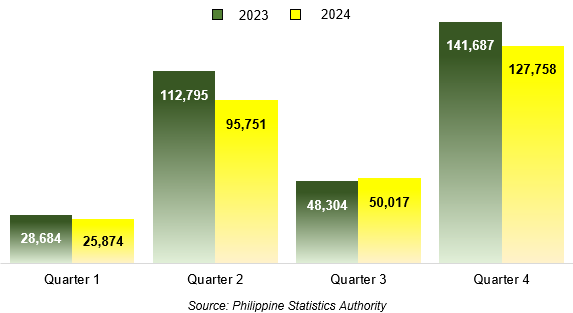
In 2024, the overall production of palay in the Cordillera region declined compared to 2023, with the third quarter of 2024 being the only period in which production exceeded the previous year’s output - recording 50,017 metric tons versus 48,304 metric tons. Total palay production was recorded at 331,470 metric tons in 2023, and decreased to 299,400 metric tons in 2024, representing a 9.67% drop year-on-year.
Palay production follows a seasonal pattern, with relatively low outputs during the first and third quarters and higher volumes in the second and fourth. The fourth quarter remained the period with the highest production, reaching 141,686 metric tons in 2023 and 127,758 metric tons in 2024 (Figure 1).
Table 1. Palay Production (MT) by Province in CAR, 2023
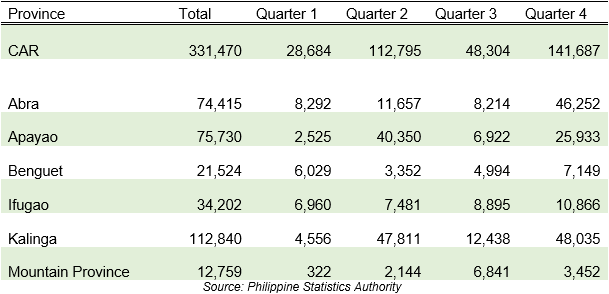
Table 2. Palay Production by Province in CAR: 2024
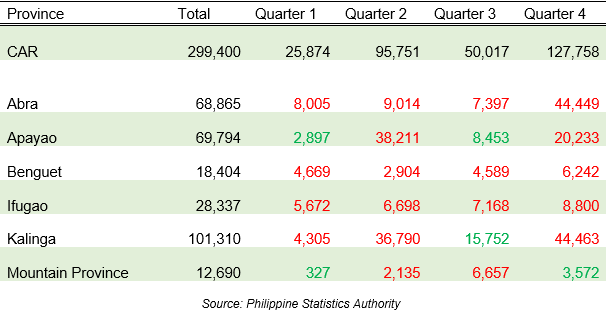
Tables 1 and 2 present the provincial disaggregation palay production for 2023 and 2024, respectively. Highlights in Table 2 indicate increases (green) and decreases (red) 2024 production relative to the same time periods in the previous year. The top contributors were Kalinga - 112,840 metric tons in 2023 and 101,310 in 2024 (contributing 34% to the total in both years) - followed by Apayao with 75,730 metric tons in 2023 and 69,794 in 2024 (each contributing 23%).
During the first semester of 2024, only Apayao and Mountain Province recorded increases in the first quarter. In the second semester, Apayao and Kalinga saw growth in the third quarter, while only Mountain Province registered an increase in the fourth.
In 2023, the provinces with the highest palay production per quarter were: Abra with 8,292 metric tons in Q1, and Kalinga with 47,811 metric tons in Q2, 12,438 in Q3, and 48,035 in Q4. In 2024, Abra remained the top producer in Q1 with 8,005 metric tons, while Apayao led in Q2 with 38,211 metric tons. Kalinga continued to lead production in the second semester, with 15,752 metric tons in Q3 and 44,463 in Q4.
Table 3. Percentage Growth of Palay Production by Province in CAR: 2024
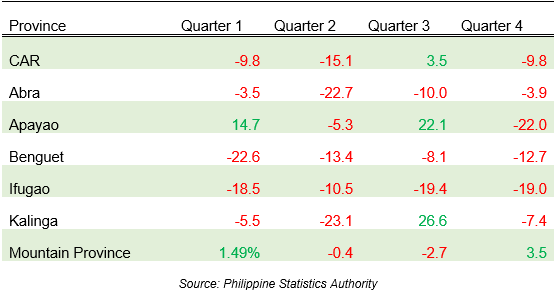
The table above presents the percent growth in palay production for each province in 2024 compared to the same periods in 2023. The most significant decline occurred in the second quarter of 2024, with a 15.1 percentage point decrease from the previous year’s production volume.
In the first quarter of 2024, four out of six provinces reported a decline in palay production, likely due to drought conditions and insufficient water supply. Among these, Benguet experienced the largest drop, with a 22.7 percentage point decrease. The observed increases in Apayao and Mountain Province were attributed to the use of quality seeds and additional fertilizers (for Apayao), and greater adoption of hybrid seeds (for Mountain Province).
In the second quarter, all provinces recorded declines in production, primarily due to drought and inadequate water resources. A notable impact was observed in upper Kalinga, where 202 hectares of farmland were completely damaged by drought, severely affecting palay output.
Despite most provinces experiencing decreased output in the third quarter – caused by factors such as Typhoon Carina in Abra and Benguet, reduced harvested area and Lamut Irrigation System rehabilitation in Ifugao, and delayed planting with insufficient rainfall in Mountain Province – regional production still posted a net gain. This was supported by increased harvest areas in Apayao and Kalinga.
In the fourth quarter, only Mountain Province showed an increase in production compared to the previous year, largely due to an expanded harvest area and the delayed harvesting of third-quarter crops. The other provinces recorded declines due to various challenges: lodging caused by typhoons in Abra and Kalinga; uncultivated irrigated areas and unrepaired irrigation canals in Apayao; continuous strong winds, rains and erosion-realted land loss in Benguet; and reduced harvest aread in Ifugao.
Figure 2. Seasonally Adjusted Palay Production (MT) in CAR:
2020 Quarter 3 – 2024 Quarter 2
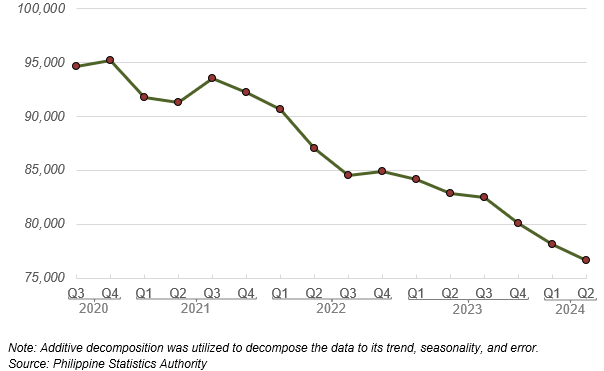
The figure above presents the seasonally adjusted trend of palay production in CAR from 2020 to 2024. Seasonal effects – typically lower production during the first and third quarters and higher output in the second and fourth – have been removed to reveal the underlying production trend. Note that data for 2020 Q1-Q2 and 2024 Q3-Q4 were excluded due to computational limitations.
As shown, the decline in palay production from 2023 to 2024 was not an isolated occurrence. Instead, the data reflect a consistent downward trend beginning in 2020, largely attributed to climate-related factors.
Figure 3. Palay Production (MT) by Ecosystem, CAR: 2024
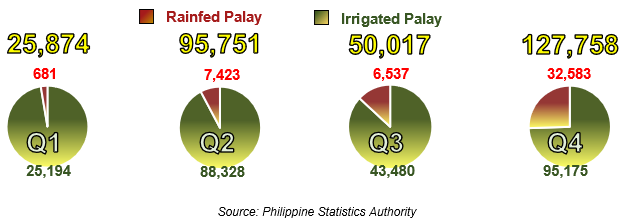
The figure above shows the quarterly disaggregation of palay production in CAR for 2024. Thoughout the year, irrigated palay consistently oputpaced rainfed palay; however, rainfed palay’s share gradually increased as the year progressed.
In the first quarter, irrigated palay accounted for 97.4% of total production, while rainfed palay contributed only 2.6%. By the second quarter, rainfed palay’s share rose to 7.8%, with irrigated palay comprising the remaining 92.2% - a shift attributed to the transition from the dry to the rainy season.
In the third quarter, irrigated palay maintained a dominant share at 86.9%, while rainfed palay increased its contribution 13.1%. By fourth quarter, rainfed palay’s share reached 25.5%, with irrigated palay making up 74.5% of the total output.
(SGD)
VILLAFE P. ALIBUYOG
Regional Director
Designation Initials Date
CSS AFRBJ 30 June 2025
SuSS WBM 26 June 2025
SrSS MVVDG 25 June 2025
SA EJDVC 24 June 2025
Technical Notes
Irrigated refers to areas with irrigation facilities supplying water through artificial means like gravity, force/power, pump, etc. Irrigated area becomes rainfed only when irrigation system is no longer operational for the past two (2) years and beyond repair and there is no plan of irrigating the farm.
Metric ton refers to a unit that is being used which is equal to 1,000 kilograms.
Palay Production refers to the quantity produced and actually harvested for palay during the reference period. It includes those harvested but damaged, stolen, given away consumed, given as harvester’s and thresher’s shares, reserved, etc. It excludes those produced but not harvested due to low price, lack of demand, force majeure, or fortuitous events, etc.
Rainfed refers to areas where palay grown on this ecosystem has dikes that retain water and is solely dependent upon rainfall for its water supply. Rainfed can be converted to irrigated only if area is laid with permanent irrigation facility.
Seasonality is a regular periodic pattern of fluctuations that repeats from year to year. Each observation period is called a season, and the number of seasons within a year is referred to as periodicity or the length of the seasonality.

